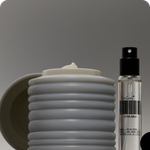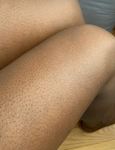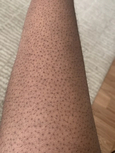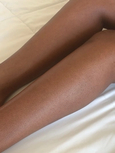Strawberry Skin
straa · beh · ree –skinA common condition where shaving-damaged follicles on the legs become enlarged and clogged, creating the appearance of small dark spots resembling strawberry seeds. Hence the name, strawberry legs.
Also Called
Strawberry legs
Frequently Found On
Legs
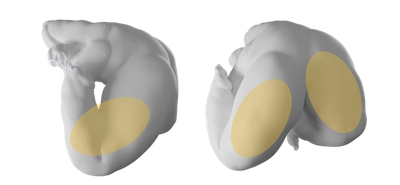
Looks Like
View GalleryWhat is strawberry skin?
Strawberry skin or strawberry legs (both terms will be used interchangeably throughout this page), is a catchall term for any number of skin conditions and concerns that produce the appearance of dark spots on the legs corresponding with the location of hair follicles and pores. Dark, sometimes pitted or raised, strawberry-seed-like spots that dot the legs are the hallmark of the condition, which is why it’s called strawberry skin.
Often people will use the term strawberry legs to describe what are actually ingrown hairs, keratosis pilaris, or folliculitis, but those are specific skin conditions that should be treated accordingly. Ingrown hairs are trapped hairs that curl back into the skin rather than growing out of it, keratosis pilaris occurs when hardened plugs of dead skin cells form around the hair follicle, and folliculitis is a condition in which hair follicles become inflamed due to a bacterial or fungal infection.1 Strawberry skin is generally not accompanied by pain or itching, if the presence of black dots or bumpy skin on the legs is accompanied by discomfort, a dermatologist should likely be consulted.
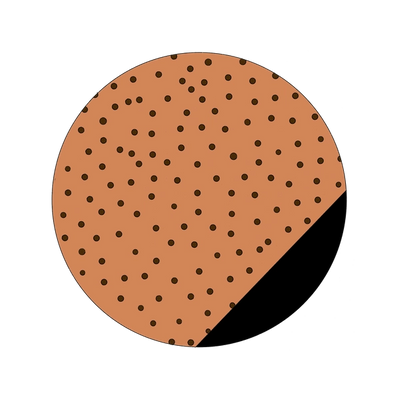
Strawberry legs is a completely harmless condition, a natural byproduct of having pores and hair follicles—something every human has—and a common side effect of shaving. Entirely erasing the appearance of leg pores is likely only possible through photo editing, but strawberry skin can definitely make those pores more noticeable. Fortunately it can be prevented and treated through at home remedies and a few easy tweaks to shaving and skincare routines.
What causes strawberry skin?
The appearance of strawberry legs is generally caused by one of two things: shaved hair in the follicle that is darker than the skin around it, or clogged pores and follicles where the trapped material oxidizes and darkens—also known as an open comedone or a blackhead. Shaving opens up the pores and follicles on them, creating the ideal environment for a buildup of oils (sebum), dead skin cells, and bacteria. This is why strawberry skin occurs after shaving.
With a razor shave, the hair is cut off as close to the root as the razor can get, which isn’t actually all that close. That’s why if the hair is darker in color than the skin around it, it’s not uncommon to begin to notice tiny dark spots appearing all over the legs a day or two after shaving.
When using a razor that’s not the sharpest or the newest—especially if it’s kept it in the shower—bacteria can easily be introduced into the freshly-opened follicles. A dull razor can also cut, irritate, and inflame the skin, making the dark spots appear more prominent. Other poor shaving techniques like not using a moisturizing shaving product, making several passes over the same area, not rinsing the razor between passes, shaving too aggressively, and using excessively hot water in the bath or shower, can result in enlarged and inflamed follicles too.
Dry skin and skin that needs exfoliating because of an excess of dead skin cells equals excellent material for clogging pores. Dehydrated skin is also more susceptible to irritation during shaving, which will exacerbate the appearance of strawberry legs.
Wearing tight clothes that trap sweat in a hot or humid climates, or keeping sweaty leggings on after working out create the perfect environment for bacteria, which is also great at clogging pores. If follicles and pores are already clogged up with oil and dead skin cells, and then get further clogged with bacteria, this can cause bumps, pimples, or worse—possibly lead to the kind of infection that causes folliculitis.2
How can I treat strawberry skin?
How to get rid of strawberry skin is all about getting rid of the conditions that make it possible. In this case that means two things you’ll see mentioned often on this site: exfoliate and moisturize.
Look for a cleanser or leave-on treatment containing salicylic acid, a beta-hydroxy acid that loves sebum (the oil your skin produces), and start using that wherever strawberry skin is visible. Over time this should clear out the buildup of material in clogged pores and hair follicles.3
Other chemical exfoliants can also help clean up clogged pores. AHAs (alpha-hydroxy acids) like glycolic acid and lactic acid do a good job of loosening up and cleaning out unwanted material on skin. AHAs can provide a good alternative to salicylic acid, which can sometimes irritate sensitive skin. Lactic acid is a great AHA for sensitive skin and also has moisturizing properties—a real bonus as a lot of AHAs & BHAs can dry skin out.4
Treating dry skin is next in the quest to rid yourself of strawberry skin. The chemical exfoliation will take care of the excess dead skin cells that accompany dry skin, but it won’t prevent them from coming back. Only improving the overall hydration level of the skin will do that. This is accomplished first by getting skin to accept hydration, and then encouraging it to retain that moisture better. A cleanser containing a chemical exfoliator will break down the barrier of dead skin cells that can prevent dry skin from absorbing moisture, and following that up with proper moisturizing techniques will help to retain it.
Applying moisturizer to skin while it’s still wet from the shower or bath prevents the water on the skin’s surface from evaporating, allowing it to penetrate the skin and hydrate more deeply. Consider one that contains ceramides which are lipids (fats) that naturally occur in high concentration in the skin and can be found as an ingredient in many moisturizers. Sealing this in with a layer of oil is extra credit—giving skin the best chance at holding on to as much of that moisture as possible for as long as possible.5
Skin needs hydration even if it isn’t freshly washed, so don’t be afraid to lotion up even if it’s not a shower or bath day, particularly when trying to get rid of a case of strawberry legs. Do be mindful of the fact that buildup of excess product is one of the things that can clog pores though, so try not go too many days between bathing.
If treating strawberry skin with exfoliation and hydration doesn’t work, what’s visible might not be clogged pores and follicles, but just hairs that are darker in color than the skin that’s around them. If that’s the case, the only way to “treat” this particular kind of strawberry legs is with a hair removal method that removes the follicle altogether. That means laser hair removal, epilators, or waxing. It’s important to note that these methods take time to see long lasting results, and will likely cause inflammation of the hair follicles themselves.
If the strawberry skin in question doesn’t respond to increased exfoliation and hydration or hair removal at the follicle, check in with a dermatologist because some kind of serious infection might be the culprit.
Mass Index Recommends:

Soft Services
Buffing Bar
$30
net wt 3.75 oz (2)
fragrance-free
This is a set of two physical exfoliating bricks for body skin made of fine sanding crystals compressed within a moisturizing, soothing base.

Soft Services
Smoothing Solution
$30
3.3 fl oz
fragrance-free
This is a leave-on chemical exfoliant containing 10% AHA to dissolve build-up of dead skin cells and soothing ingredients to calm visible irritation.

Skinfix
Resurface+ Glycolic Renewing Scrub
$30
8 oz
pre-shower scrub
Scrub that’s applied before showering to let two chemical exfoliants—glycolic and lactic acids—penetrate the skin to clear away dead skin, oil, and bacteria that clog pores lead to strawberry legs.
Soft Services works with experts to review the accuracy of our content, but they do not endorse the products we made.
How do you prevent strawberry skin?
Preventing strawberry skin—the clogged pores and inflamed follicles that can be a common byproduct of shaving—are pretty easily managed.
Prepare skin by doing some gentle physical exfoliation before getting started shaving. It’s the best way to make sure the skin is as free as possible of dead skin cells, which can clog up and dull a razor almost immediately. There are tons of ways to physically exfoliate (body scrubs, dry brushing, body mitts), but the important part is to be gentle with it. The goal is to remove dead skin, not cause inflammation, which could exacerbate the appearance of strawberry skin.
Fresh razors give the best shaves both in terms of hygiene and closeness, so rather than an expensive multi-blade situation, a fresh, sharp, single-bladed option might be a better choice. This obviously depends on budget, frequency of shaves, and preference—but a newer, sharper, blade will always perform better than one with more shaves under its belt. A lot of people keep their razor in the shower, which makes sense, it’s convenient. Unfortunately, it also encourages things like rust and bacteria to grow which can then be introduced to newly shorn follicles on the leg. It’s best to dry and store your razor outside of the shower.6
When shaving, make sure to use a hydrating shaving solution. Hair conditioner works surprisingly well—it softens (and moisturizes) the skin and the hair, and lets the razor glide along the skin without damaging it. If shaving cream is preferred, look for a hydrating formula. Try not to make several passes over the same area and shave in the direction the hair grows. This might seem counterintuitive, and shaving this way doesn’t produce as close a shave as shaving against the grain, but it does prevent the hairs from being pulled in the opposite direction from how they grow, and then getting violently snapped back the other way once the razor chops them off. Which is of course how the follicles get stretched out, making room for all that gunk, and voila: strawberry legs.
Keeping legs well exfoliated is another key step in preventing strawberry legs. In addition to preparing for shaves with physical exfoliation, the regular use of chemical exfoliants on skin will keep dead skin at bay, pores clear, and skin ready to accept moisture. There are body cleansers with AHAs like glycolic and lactic acids and BHAs like salicylic acid that can be used sporadically to keep skin exfoliated. There are also countless AHA and BHA leave-on serum and gel products, even AHA and BHA body lotions and creams.
Skin that is well exfoliated is better prepared for hydration, which will help in preventing strawberry skin. There are a few more things to try that aren’t completely obvious that can help skin achieve optimal moisturization.
As good as a hot shower feels, hot water is mostly good at drying out skin. Keeping shower and bath water closer to body temperature will prevent the oils that are necessary to skin’s hydration from being stripped away while bathing. It’s also a good idea to choose a cleanser that isn’t stripping, drying, or overly lathering. All of these run the risk of robbing skin of the oils it wants to hang on to.
When finished bathing, don’t scrub across your skin with a towel dry. Gently pat, and don’t worry about getting all the water off. If there’s still water on the skin when moisturizers are applied, especially when using a body oil, then the skin can absorb and retain that moisture, along with the added hydration the product provides. So always be sure to moisturize as soon as possible after getting out of the bath or shower.7
If hair that’s darker than the skin around it is the culprit behind the appearance of strawberry legs, then the only thing that can prevent it is removing that hair from the root of the follicle and even then, in most cases, the hair will eventually come back.
Waxing pulls hairs out from the root which keeps legs free of their strawberry look much longer than shaving, but not indefinitely.
Laser hair removal uses a concentrated beam of light to zap and burn up the shaft of hair, all the way down to the follicle. While many expect laser hair removal to kill off follicles altogether resulting in permanent hair removal, there isn’t data as of yet that supports those claims. Research has however shown that laser hair removal can and does produce a reduction in hair counts (the number of active follicles in a certain area of skin), especially after multiple treatments.8
There are at-home DIY laser hair removal kits but they don’t have actual lasers as their light source and generally only work for folks with dark hair and lighter skin. For the real deal, visit a licensed, board-certified dermatologist for laser hair removal treatments.
The only hair removal method deemed permanent by the FDA is electrolysis—a process where a small needle is inserted into the follicle and an electric current is sent through it to kill the follicle.9 As thorough treatment requires the elimination of each individual follicle, electrolysis often calls for multiple, sometimes painful sessions to completely remove hair from an area of the body. A body part as large as the legs (where strawberry skin most commonly occurs) will require many lengthy sessions over several months to achieve permanent hair removal.10
However, once the needed electrolysis sessions for a particular area are completed, the follicles will be dead forever—eliminating strawberry skin and hair regrowth concerns permanently.
Citations
1Folliculitis by Mayo Clinic Staff.
2Folliculitis: recognition and management by Luelmo-Aguilar, J., Santandreu, M.S. Am J Clin Dermatol.
3Salicylic acid treats acne vulgaris by suppressing AMPK/SREBP1 pathway in sebocytes by Lu J, Cong T, Wen X, Li X, Du D, He G, Jiang X. Exp Dermatol.
4Lactic and lactobionic acids as typically moisturizing compounds by Algiert-Zielińska B, Mucha P, Rotsztejn H. Int J Dermatol.
5The 24-hr, 28-day, and 7-day post-moisturizing efficacy of ceramides 1, 3, 6-II containing moisturizing cream compared with hydrophilic cream on skin dryness and barrier disruption in senile xerosis treatment by Lueangarun S, Tragulplaingam P, Sugkraroek S, Tempark T. Dermatol Ther.
6How to Shave by American Academy of Dermatology.
7Dermatologists’ Top Tips for Relieving Dry Skin, by American Academy of Dermatology.
8Evidence-based review of hair removal using lasers and light sources, by Haedersdal M, Wulf HC et al. J Eur Acad Dermatol Venereol.
97 Ways to Remove Unwanted Hair, by American Academy of Dermatology.
10Comparison of alexandrite laser and electrolysis for hair removal, by Görgü M et al. Dermatol Surg.
Additional References:
Dealing with the Difficulties of Dry Skin by Mayo Clinic Staff.
The effect of physically applied alpha hydroxyl acids on the skin pore and comedone by Kim SJ, Baek JH, Koh JS, Bae MI, Lee SJ, Shin MK. Int J Cosmet Sci.
How to Safely Exfoliate at Home by American Academy of Dermatology.
Strategic Targets in Acne: The Comedone Switch in Question by Saurat JH. Int J Cosmet Sci.
Get Updates
There’s more to come.
Sign up to receive periodical updates on Mass Index, and to be the first to know when Soft Services launches new products. (If we don’t have any updates, we won’t email you.)

